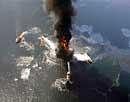
British Petroleum made a third attempt Friday night at what is termed the 'junk shot,' a procedure that involves pumping odds and ends like plastic cubes, knotted rope, and golf balls into the blowout preventer, the five-storey safety device atop the well, the Times-Picayune reported.
The manoeuvre is complementary to the heavily scrutinised effort known as a "top kill," which began four days ago and involves pumping heavy mud into the well to counteract the push of the escaping oil.
The technician working on the project yesterday said pumping had again been halted and a review of the data so far was under way.
"Right now, I would not be optimistic," he said on condition of anonymity adding if another attempt at the junk shot were to succeed that would turn things around.
BP chief operating officer Doug Suttles told reporters yesterday that so far the attempt to stem the flow using heavy drilling mud and junk shots has not worked.
The comments from Suttles came amid increasing scepticism that the "top kill" operation would halt the leak.
If the top kill fails, BP would cut off the damaged riser from which the oil is leaking and cap it with a containment valve that's already resting on the seafloor. BP is already preparing for that operation, he said.
Suttles also defended BP’s clean-up efforts, which have come under fierce criticism from local politicians for being too little too late.
"We have been ramping up the activity every single day," he said referring to the workers that are being brought in to mop up the rust-coloured goo that is washing ashore along the coast here.
"We and the Coast Guard are bringing in additional resources," he added.
BP estimates it has nearly 2,000 workers already along the coast according to David Nicholas, BP spokesman.
Suttles said the company was somewhat hampered in its efforts to be aggressive by the delicate nature of the ecosystem.
"We don’t want to create more harm in doing the cleanup than the oil creates on its own," he said.
Nevertheless, he added, BP was not only bringing in more people it was working on ways to get them to more inaccessible areas of the coast.
Suttles said they were going to start using tent cities and 'flo-tels' or floating hotels to house workers closer to hard to reach marsh lands being covered with oil.
It is expected that BP will announce that its next option to try to plug the leak which will involve cutting off the leaking pipe to get a clean-cut surface, capping it and diverting the leak into another pipe.
The company is now re-evaluating whether it will keep trying the top kill or move onto the next backup plan, placing a reconfigured cofferdam over the runaway riser on top of the well. A similar plan failed earlier this month.
Before the procedure was started, BP officials reported that in 24 to 48 hours they will know if it was successful. Now that term has been backed off to Saturday, according to Tom Mueller, the BP spokesman.
Not only the citizens are asking for actions, US President Barack Obama himself has been on top of this issue from the very beginning.
Obama and Chief Executive Tony Hayward have traveled to Louisiana and met the concerned residents. The credibility of the Obama administration and also the prestige of BP is in stake if this oil spill takes larger proportions.
Since April 20, after the rig explosion 11 workers have died and the unleashed oil spill is gushing through the Gulf destroying the wildlife environment.
At 18,000 feet into the bedrock lies the Macondo oil deposit, which, thanks to the Deepwater Horizon accident, is now spewing its crude cargo at between 14,000 and 19,000 barrels of oil a day into the Gulf of Mexico.
Estimated by BP to hold 50 million barrels, the seam of oil has emptied as much as 740,000 barrels or about 1.5 per cent of the total. Because of the immense pressures of the earth's innards, geologists say, the deposit will completely unload into the Gulf unless the Deepwater Horizon well is capped.
With those numbers literally pressing up from the earth's core, BP and government scientists are running out of immediate options to kill the runaway well.
Another back-up plan in the works is to place a second blowout preventer on top of the one that failed after a "kick" of gas exploded on the Deepwater Horizon on April 20, killing 11 and causing the nation's worst-ever oil spill disaster.